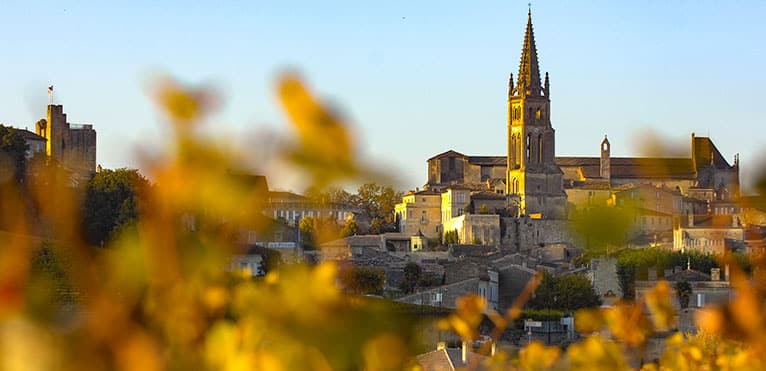
Contents
The Canon-Fronsac appellation is located on the right bank of Bordeaux in the
sub-region of Libourne and produces exclusively red wines. They hold both the Appellation d’Origine Contrôlée and the Appellation d’Origine Protégée labels.
Between fame and oblivion: the tumultuous history of Canon-Rronsac
This appellation, famous until the 18th century, fell into oblivion over the following centuries. Today, the quality of Canon-Fronsac wines, recognized in 1939, and their affordable prices are restoring this AOC to its former glory.
The history of this appellation is also marked by the history of its grape varieties. Until 1990, the vineyard was planted mainly with Malbec. As this grape variety is too sensitive to the frost that strikes the Bordeaux region during the winter, the appellation has no choice but to change its grape varieties. Merlot, a minority variety at the time, now represents 75% of the grape varieties used in the winemaking process. Its charter also stipulates that the density of grape varieties must not exceed 5,000 plants per hectare, for a maximum wine production of 53 to 63 hectolitres per hectare.
The Canon-Fronsac AOC produces only blended red wines.
Together with the Fronsac appellation, the Canon-Fronsac appellation forms the wine-growing area known as the Fronsadais. It covers an area of 300 hectares in the communes of Fronsac and Saint-Mihiel de Fronsac. It is therefore located to the north of Saint-Emilion and Pomerol, benefiting from the temperate oceanic climate that characterizes the Bordeaux region.
Because of its proximity to Saint-Emilion, the vineyard’s soils are very similar to those of the neighboring vineyard: they are mostly limestone, covered with “molasses du fronsadais”.
The relief of this region allows water to run off easily, thus limiting stagnation, which would be unfavorable to vine growing. The vineyards are also protected from frost by the Isle and Dordogne rivers, which regulate temperatures.
This vineyard is characterized by the production of blended wines. The dominant grape variety used for production must represent 50% or more of the proportion of the blend. The wines are made with a blend of Cabernet Franc, Cabernet Sauvignon and Merlot.
AOC Canon-Fronsac wines are remarkably full-bodied
The red wines of the Canon-Fronsac appellation look similar to most Bordeaux wines. It has a dark ruby color and is generally tinged with purplish highlights.
When the wine is young, the nose is elegant and fine. Delicate red fruit and spice aromas. With age, the wine’s secondary aromas become even more complex, giving off notes of truffle, due in large part to the barrel ageing of these wines.
The palate, meanwhile, offers a distinctive grain, a fine consistency and a remarkable balance between tannins and fruitiness. What’s more, like the Pomerols, Canon-Fronsac wines are generally quite fatty, which gives them an interesting personality.
These wines express their full potential between 4 and 12 years after bottling.
The marriage of Canon-Fronsac with Bordeaux dishes
The tannic structure of these wines in no way detracts from their delicacy. These are delicate, remarkable wines, thanks to a balanced combination of red fruit aromas and spicy notes. It’s a perfect match for red meats such as entrecote steak, small game, mushroom fricassee and certain cheeses. They also go perfectly with lamprey à la bordelaise. What’s more, they are at their most expressive when drunk between 16 and 17 degrees Celsius.
Great vintages for AOC Canon-Fronsac
The Canon-Fronsac appellation has stood out for the quality of its wines over several vintages. In 2005, these wines were recognized as millennium vintages for the appellation. The years 1990 and 2009 stand out as centenary vintages. Finally, in 1989, the appellation distinguished itself with the production of an exceptional cru.
Ecology at the heart of the Canon-Fronsac appellation’s ambitions
Château Canon Pécresse
The history of this Canon Fronsac winery is closely linked to the history of the wine merchants of Correze, who traded and contributed to the development of the Bordeaux vineyards in the late 19th and early 20th centuries. Francis Pécresse is one of them, and after investing in estates in Saint-Emilion and Pomerol, his attention is now focused on the Canon-Fronsac appellation. That’s why, in 1945, he acquired Château Vray Canon Bodet-la-Tour, now known as Château Canon Pécresse. Aware of the potential of this small estate of 4.5 hectares of black Merlot and Cabernet Franc, he already believed, at the time, in its ability to produce racy, deep wines. Today, his heirs are committed to making the Château a benchmark in the Fronsadais region, and to promoting their terroir. They are also driven by ecological ideals, the vineyard has been in conversion to organic farming since 2017.
Vignobles Paul Barre
This vineyard, located in the village of La Grave, covers an area of 6.9 hectares. Its name comes from its former owner Paul Barre, who, driven by strong ecological values, can be presented as the father of biodynamic agriculture in the Bordeaux region. Indeed, he has been working on this project since the 1990s, and his vineyard, now managed by his son Gabriel, produces quality wines with typical Bordeaux grape varieties such as Merlot and Cabernet Franc.